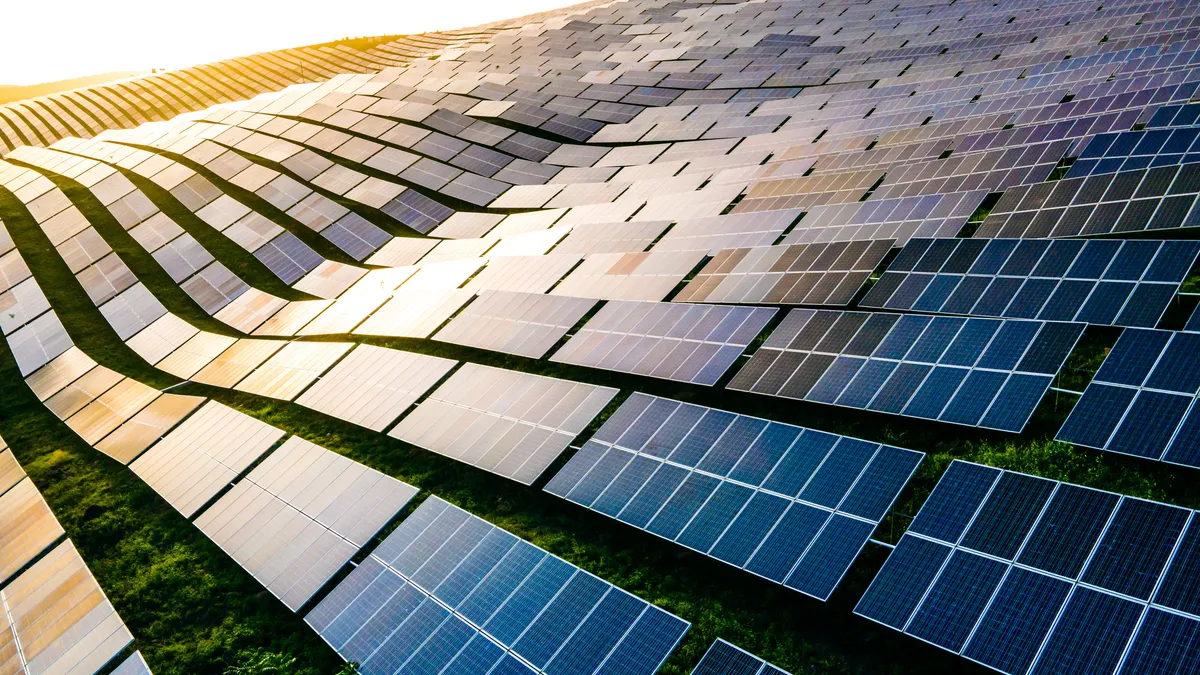Dive Brief:
- The central and Western United States will face elevated reliability risks this summer, as extreme temperatures, drought conditions and higher peak demands challenge grid operators, according to analysis published Wednesday by the North American Electric Reliability Corp.
- Among those regions, the Midcontinent Independent System Operator is at highest risk and could face a resource shortfall during normal operating conditions, NERC officials said. Peak demand in the region is expected to be 1.7% higher this year than last, while resource commitments declined in the operator's most recent planning auction.
- Grid operators may also struggle with cybersecurity threats, supply chain issues and the potential for disruptive wildfires, according to NERC officials. But the biggest long-term risk may be the unexpected tripping of solar resources during grid disturbances, for which NERC is currently developing new rules, they said.
Dive Insight:
The unexpected tripping of solar generation is just one item on a list of reliability issues this summer, but as more solar is interconnected NERC officials say it could become a major threat.
"The inverter tripping challenge is really one of the most risky issues we have to deal with as an industry in order to ensure we can reliably interconnect the nearly 500 GW of solar we see coming online in the next 10 years," NERC Director of Reliability Assessment and Performance Analysis John Moura said Wednesday in a call with media.
The unexpected tripping has occurred during "normal grid disturbances" such as a lightning strike or another piece of equipment going offline. An early occurrence was witnessed in 2016, when California’s Blue Cut Fire tripped several transmission lines and caused almost 1,200 MW of solar energy capacity to go offline unexpectedly. Similar losses of solar generation also occurred between May and August in California and Texas last year.
While 1,200 MW is a relatively small loss, "these types of risks have the potential to have widespread impacts across the entire interconnection," Moura said.
NERC is starting to develop reliability standards to improve solar resource performance, said Moura.
Beyond the solar tripping issue, NERC's 2022 Summer Reliability Assessment also identified supply chain concerns as a threat to the grid in areas where the completion of new generation or transmission resources is needed for reliability during summer peak periods.
"Assessment areas report that some generation and transmission projects are being impacted by product unavailability, shipping delays, and labor shortages," the report said, pointing to California, Texas and parts of the Southwest in particular.
Cyber threats, wildfires and a shortage of fuel and non-fuel coal generation inputs are also issues NERC is watching.
"It's a sobering report," said Moura. "It's clear the risks are spreading. ... and the pace of our grid transformation is a bit out of sync with the underlying realities and the physics of the system."
Climate change is also shifting how NERC performs its assessment. Past iterations focused on planning reserves and normal weather, but "now we're really looking at extreme weather," said Moura. "And what we've all learned in recent history, is that extreme doesn't mean rare."
"A big challenge is the persistent drought over the western half of North America," NERC Manager of Reliability Assessments Mark Olson said. Drought can reduce hydroelectric output as well as setting the conditions for more extreme heat, or reducing the availability of some thermal generation.
MISO is considered a "high" risk for running short on operating reserves under normal conditions, according to NERC. The grid operator faces a 5 GW shortfall and said in April that it is working with member companies “to prepare for the worst-case scenarios.”
Six other areas are an "elevated" risk, according to the report, particularly in the event of extreme weather.
Texas has boosted reserve margins through the addition of wind and solar generation, but NERC still considers it an elevated risk area due to the potential for extreme weather and the ongoing drought. The grid operator for most of the state on Tuesday said it is ready for summer, though it was forced to call for conservation last weekend after multiple generators failed.
California and parts of the western interconnection are also at elevated risk, particularly in late summer as water resource levels decline and solar output begins to fall off earlier in the day.
"Operators in California will rely increasingly on transfers to make up for their demand," Olson said, though extreme heat could reduce the availability of power imports.
Demand growth in parts of the Southwest has been matched by a growing resource base, but there are concerns that drought conditions could reduce water sources used by generators that rely on once-through cooling. Above-normal loads and outages could mean operators are forced to turn to demand response and energy imports. "Load shedding may be needed under extreme peak demand and outage scenarios studied," NERC said.
In Saskatchewan, the only part of Canada at elevated risk, Olson said there has been little change in the existing generation, and capacity will be strained to meet peak demand projections that have risen by over 7.5% since last summer. If generators are forced offline for any reason, "external assistance might be needed to maintain reliability," he said.
The potential for extreme weather and energy shortfalls in multiple regions echoes NERC's 2021 report.
"Once again, we put the grid owners and operators on notice for challenging summer conditions," Olson said.















